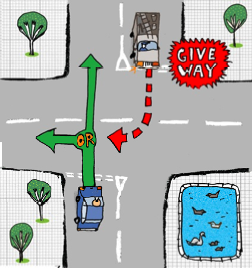
Navigating the Rules: Can Learner Drivers Have Passengers?
Imagine the scene: you’re sitting in the driver’s seat, your hands are on the wheel,
When two roads meet, we call one of them major, the other minor. Traffic on the major road has priority; traffic on the minor road must give way. You can tell which is which by the road markings.
What is a left turn?
In this section, a left turn is a turn from a major road to a minor road.

1. Road signs: red-bordered warning triangles tell you that you’re approaching a junction
2. Road markings: you’ll see them on the left of the road ahead
3. Buildings: a gap in a row of buildings could indicate a junction
4. Parked cars: a gap in a row of parked cars could indicate a junction
5. Moving cars: cars emerging from the left could indicate a junction
When you’ve spotted the junction at which you want to turn left, follow the MSPSL routine.
Mirrors
Signal
Position
Speed
Look
Wimbledon Driving School
The Long Lodge
265 – 269 Kingston Road
Wimbledon,
London, SW19 3NW
Phone: 0800 511 8800

Imagine the scene: you’re sitting in the driver’s seat, your hands are on the wheel,

Are you feeling the weight of unease each time you sit behind the wheel? You’re

Are you ready to hit the road and embark on the exciting journey of learning